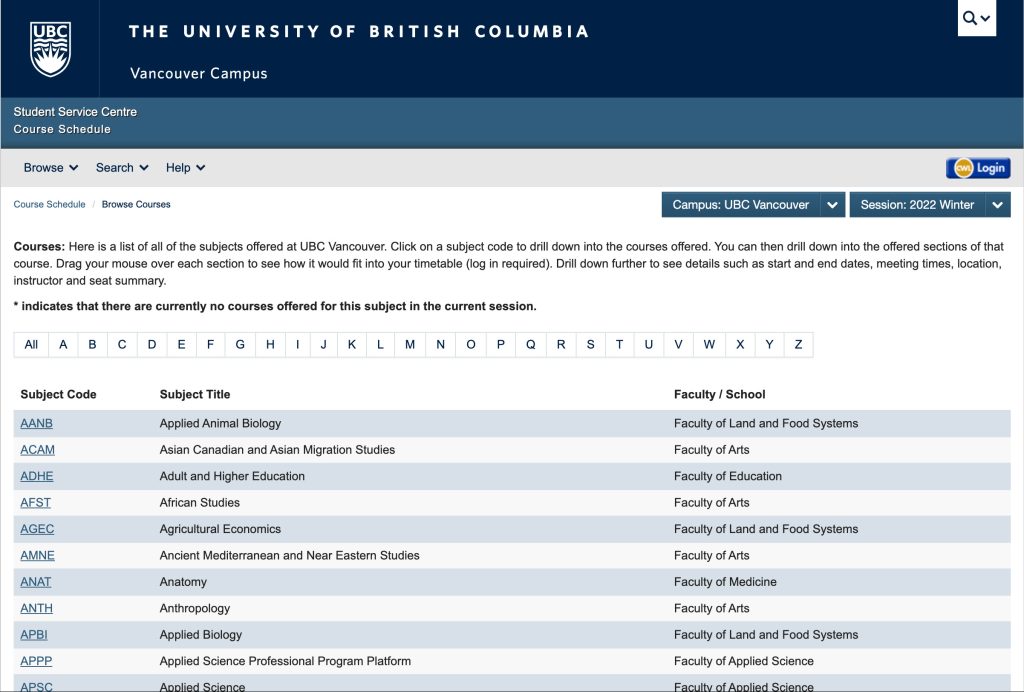

By Sarvenaz Oloomi BA ‘22, former Arts Peer Advisor
Before your registration day, it’s helpful to browse the UBC Course Schedule to find courses that spark your interest and fit within your maximum allowable credits for your first year. You can use the UBC worklist tool to plan a conflict-free timetable.
When I accepted my offer to UBC Arts, I wanted to be proactive and plan my courses before registration, so I jotted down a list of courses I needed to fulfill certain degree requirements alongside electives and credit amounts. This helped me visualize how courses would fit together to make my first-year schedule. In this blog, I’ll share five steps that you can take to begin visualizing your first-year plan.
1. Identify your first-year study option
I researched the three first-year study options, looking at how each one could be beneficial to my personal academic journey. When I applied to Arts, I knew I was interested in majoring in psychology, so I decided that the custom timetable was the right option for me as it allowed me to focus on multiple psychology courses while fulfilling degree requirements.
All three first-year study options offer unique advantages, so ask yourself which program will give you the most support during your first year as you transition to university life.
2. Consider credits and degree requirements
In Arts, you can take a maximum of 30-32 credits each Winter Session, meaning up to 5 courses each term. In order to gain second-year standing at the end of your first Winter Session, you have to complete a minimum of 27 credits.
Most single-term courses are worth 3 credits. Courses that extend across both Winter Terms and are typically worth 6 credits.
- If you choose Arts One or the Coordinated Arts Program (CAP) as a first-year study option, they are worth 18 credits over the full Winter Session and you’ll have 12 credits left to choose electives.
- With a custom timetable, you have 30 credits to work with.
It’s important to fulfill the Writing Component requirement and consider the Language requirement in your first year.
- If you choose Arts One as your first-year study option, you’ll fulfill the Writing Component and 3 credits of the Literature requirement.
- If you choose CAP, you’ll fulfill the writing requirement and some CAP streams allow you to fulfill 3 credits of the Literature Requirement.
When I was creating my course list for first-year registration, I made sure to include introductory Psychology courses, a few courses for degree requirements, and a few electives, all while staying within 30 credits for the year.
3. Navigate the Course Schedule
I’d encourage you to get familiar with the UBC Course Schedule before your registration day. Login to the Student Service Centre (SSC) and then click on the “Course Schedule” button. Once there, select the correct campus and session listed in the top right corner. When you select “Browse” followed by “Courses” in the left corner’s drop-down menu, you will be redirected to a page with all courses offered at UBC. The courses are organized in alphabetical order based on the Subject Code, which is a short code version of a course title; for example, “ENGL” is “English.”
Course details are written in this order: Subject Code, Course Number, Section Code. For example, “WRDS 150 01A” = Writing, Research, and Discourse Studies, course number 150, section 01A. The Course Number represents the level of the course — from 100 to 400 level courses. The Section Code stands for the specific scheduled time (or “section”) of the course.
When browsing the Course Schedule, be aware that you may not be eligible for all courses. Always review the prerequisites and course notes so you’ll know if a course is blocked or restricted to students in specific year-levels or majors.
4. Choose courses and electives
Explore your interests and challenge yourself through electives. I took courses that were prerequisites for my intended major in psychology, but l also looked for subjects that excited me and were recommended by my peers. For example, I took an introductory sociology course and to this date, it has been one of the most inspiring courses I have taken!
As I browsed electives on the Course Schedule, I counted credit amounts to make sure I was not exceeding 30 credits for the Winter Session. I prioritized degree requirements and then chose my electives.
To avoid course conflicts (courses being delivered at the same time), I organized my list of prospective courses by class times and the days of the week they were offered.
5. Get to know the worklist tool
Worklists in the Course Schedule let you visualize your course timetable over the entire Winter Session and test if you meet course eligibility. It’s important to note that saving courses to your worklist does not automatically register you in those courses — you still have to register on your assigned date and time.
Sometimes I create multiple worklists when a single course requires me to register in both a large lecture and a small tutorial or discussion. Tutorials and discussions have limited seating, so these extra worklists help me have a backup plan in case the course fills up before I can register for it.
Getting ready for registration and your first year
Registration dates are listed on the Enrolment Services website. You will receive an email a week prior to your official registration date informing you of your exact date and time. Take a look at your study options, degree requirements, electives, and start building Worklists before receiving the email.
Being prepared and proactive about my course planning eased my worries about university and the registration process. The transition from high school to university can be intimidating, but if you are aware of your academic decisions from the beginning, you can set yourself up for a successful undergraduate journey.





